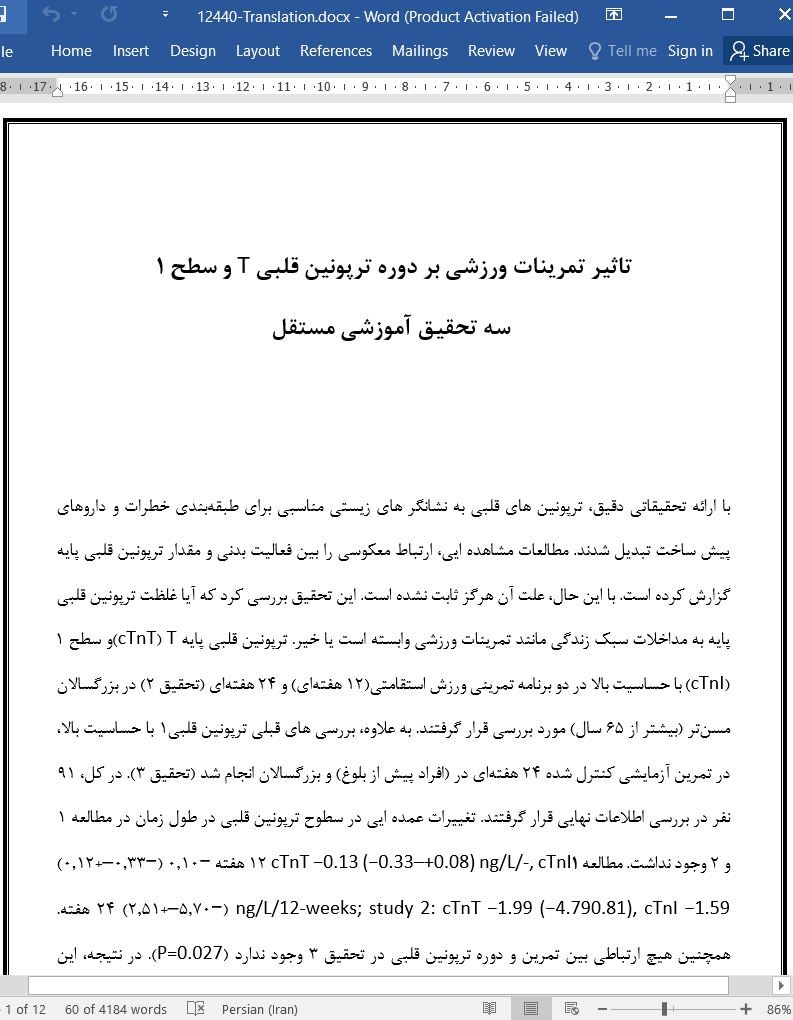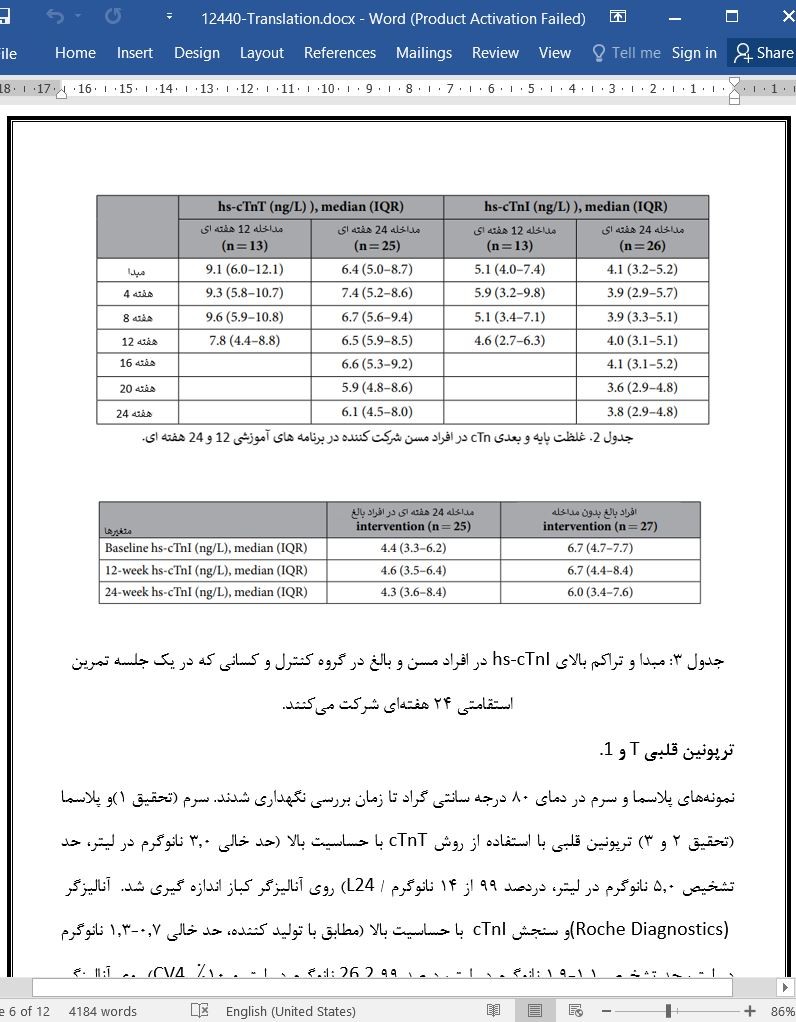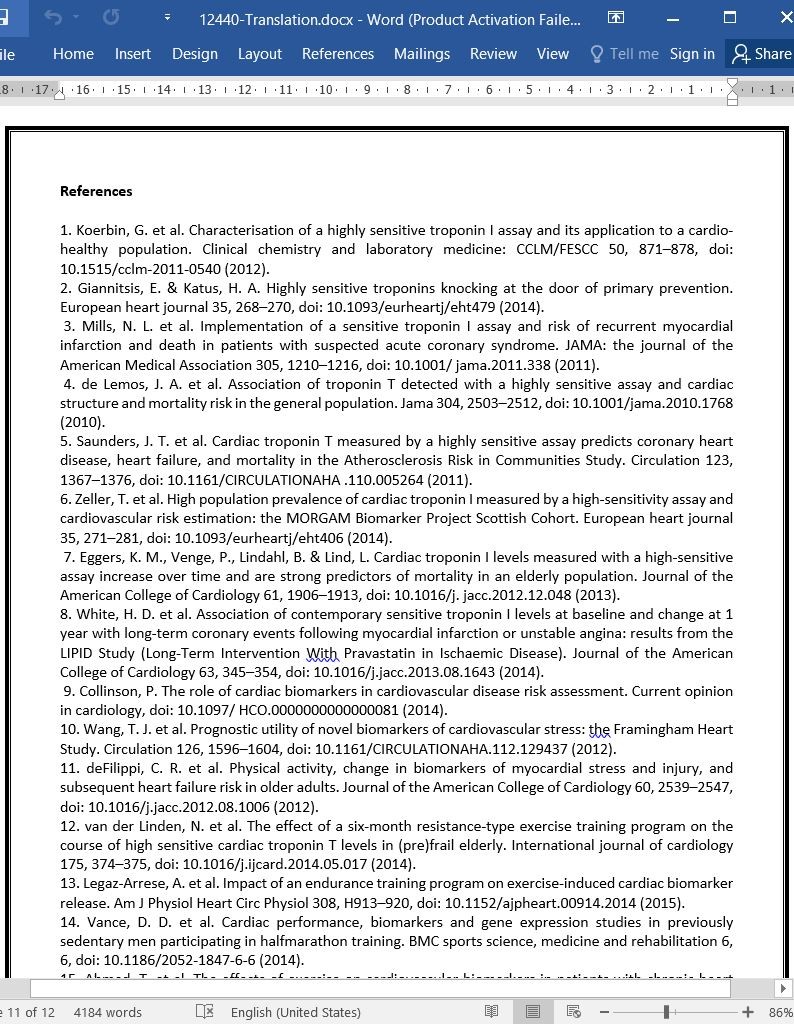
دانلود مقاله تاثیر تمرینات ورزشی بر دوره ترپونین قلبی T و سطح 1
با ارائه تحقیقاتی دقیق، ترپونین های قلبی به نشانگر های زیستی مناسبی برای طبقهبندی خطرات و داروهای پیش ساخت تبدیل شدند. مطالعات مشاهده ایی، ارتباط معکوسی را بین فعالیت بدنی و مقدار ترپونین قلبی پایه گزارش کرده است. با این حال، علت آن هرگز ثابت نشده است. این تحقیق بررسی کرد که آیا غلظت ترپونین قلبی پایه به مداخلات سبک زندگی مانند تمرینات ورزشی وابسته است یا خیر. ترپونین قلبی پایه T (cTnT)و سطح 1 (cTnI) با حساسیت بالا در دو برنامه تمرینی ورزش استقامتی (۱۲ هفتهای) و ۲۴ هفتهای (تحقیق ۲) در بزرگسالان مسنتر (بیشتر از 65 سال) مورد بررسی قرار گرفتند. به علاوه، بررسی های قبلی ترپونین قلبی1 با حساسیت بالا، در تمرین آزمایشی کنترل شده ۲۴ هفتهای در (افراد پیش از بلوغ) و بزرگسالان انجام شد (تحقیق ۳). در کل، ۹۱ نفر در بررسی اطلاعات نهایی قرار گرفتند. تغییرات عمده ایی در سطوح ترپونین قلبی در طول زمان در مطالعه ۱ و 2 وجود نداشت. مطالعه 1cTnT −0.13 (−0.33–+0.08) ng/L/-, cTnI 12 هفته −0.10 (−0.33–+0.12) ng/L/12-weeks; study 2: cTnT −1.99 (−4.790.81), cTnI −1.59 (−5.70–+2.51) 24 هفته. همچنین هیچ ارتباطی بین تمرین و دوره ترپونین قلبی در تحقیق ۳ وجود ندارد (P=0.027). در نتیجه، این تحقیق هیچ مدرکی مبنی بر اینکه تمرین ورزش استقامتی طولانیمدت، میتواند سطح ترپونین قلبی را تعدیل کند، ارائه نمی دهد.
در حال حاضر، توسعه رو به افزایش تحقیقات دقیق درباره ترپونین قلبی، به جایی رسیده است که غلظت ترپونین قلبی را میتوان به دقت در اکثر افراد جمعیت مرجع سالم ارزیابی کرد 1. به موازات توسعه تحقیقات با افزایش حساسیت، توجه به ترپونین قلبی از طریق مراقبت های شدید قلبی به منظور پیشگیری و طبقه بندی خطر، گسترش یافته است 2. تحقیقات در گروههای مختلف بیماران و افراد فاقد علائم بیماری شواهد جالبی ارائه کرده اند که نشان می دهد سطح اولیه ترپونین قلبی، نتیجه را پیشبینی میکند 3. جالب توجه است که شیب خطر مشاهدهشده به ارتفاعات بالای ۹۹ درصد محدود نمیشود، بلکه حتی در فاصله جمعیت مرجع سالم و مستقل از عوامل خطر معمول مثل سن، جنسیت و دیابت مشخص است 9-4. در تحقیق Framingham درمورد قلب، غلظت پایه ترپونین قلبی1، ارزش تشخیصی را به عوامل استاندارد خطر برای پیشبینی مرگ و بیماریهای قلبی عروقی می افزاید10. علاوه بر این، افزایش موقت غلظت ترپونین قلبی در طول زمان، خطرات قلبی عروقی را افزایش داده و با میزان آمادگی جسمانی رابطه معکوس دارد 11. این مشاهدات، اساس این فرضیه را تشکیل میدهند که ترپونین قلبی یک پارامتر قابل اصلاح است، که احتمالا به مداخلات سبک زندگی مانند برنامه تمرینات ورزشی وابسته است. در پژوهش اخیر در (افراد پیش از بلوغ) و افراد بالغ، این فرضیه که تمرینات ورزش مقاومتی تحت نظر میتواند بر دوره ترپونین قلبی در طول زمان تاثیر بگذارد، را آزمایش کردیم.
بررسی
در دو دوره تمریناتی تحت نظارت مستقل ۱۲ و ۲۴ هفته ایی، هیچ اثری از جلسات تمرین استقامتی در دوره ترپونین قلبی T و در موضوعات پیشین پیدا نکردیم، و همچنین اثری از جلسات تمرینی ۲۴ هفتهای در بیماریهای قلبی (افراد پیش از بلوغ)، پیدا نکردیم.
نتایج حاصله، شامل این نظریه که سطوح ترپونین قلبی از طریق ورزش تغییر می کند، نمی شود. این فرضیه توسط مطالعات مشاهداتی به وجود آمد و نشان داد که میزان فعالیت فیزیکی بالا در افراد مسن با سطوح پایین cTnT و احتمال افزایش چشمگیر غلظت cTnT بین روزهای متوالی، مرتبط هستند.۱۱، ۲۶. برای بررسی اینکه آیا رابطه علت و معلولی پشت این ارتباط وجود دارد، یک سری مطالعات تمرینی درباره موضوعاتی انجام دادیم که در آن سطوح ترپونین قلبی بالا رایج است، و بنابراین، حداقل از لحاظ نظری، بیشتر متاثر از اثرات مطلوب یک مداخله هستند. برای اطمینان از اینکه سطوح ترپونین قلبی به جای عوارض حاد ورزش مورد بررسی قرار گرفتند، فاصله ایی سه روزه بین جلسات تمرینی و نمونهگیری خون، قرار دادیم ۲۷. هیچ یک از این مطالعات اثر مطلوبی از جلسات تمرین استقامتی در سطوح ترپونین قلبی نشان ندادند. الگوی بی ارتباط ترپونین قلبی T و I در جلسه تمرینی برخلاف تغییرات مفید مشاهدهشده در قدرت پا، توده عضلانی، حساسیت انسولین، کلسترول، کلسترول کلی و LDL ۱۸ - ۲۰، ۲۲، ۲۳ است. نتایج حاضر، نتایج بررسی مداخله تمرینات قبلی ما در افراد مسن و بالغ را، تایید کرده و گسترش میدهد، که همچنین با اثرات مطلوب بر عملکرد فیزیکی، و عدم تاثیرگزاری بر گردش ترپونین قلبی مشخص میشود.
With the introduction of high-sensitive assays, cardiac troponins became potential biomarkers for risk stratification and prognostic medicine. Observational studies have reported an inverse association between physical activity and basal cardiac troponin levels. However, causality has never been demonstrated. This study investigated whether basal cardiac troponin concentrations are receptive to lifestyle interventions such as exercise training. Basal high-sensitive cardiac troponin T (cTnT ) and I (cTnI) were monitored in two resistance-type exercise training programs (12-week (study 1) and 24-week (study 2)) in older adults (≥65 years). In addition, a retrospective analysis for high sensitive troponin I in a 24-week exercise controlled trial in (pre)frail older adults was performed (study 3). In total, 91 subjects were included in the final data analyses. There were no significant changes in cardiac troponin levels over time in study 1 and 2 (study 1: cTnT −0.13 (−0.33–+0.08)ng/L/12-weeks, cTnI −0.10 (−0.33–+0.12)ng/L/12-weeks; study 2: cTnT −1.99 (−4.79–+0.81)ng/L/24-weeks, cTnI −1.59 (−5.70–+2.51)ng/L/24-weeks). Neither was there a significant interaction between training and the course of cardiac troponin in study 3 (p=0.27). In conclusion, this study provides no evidence that prolonged resistance-type exercise training can modulate basal cardiac troponin levels.
The development of increasingly sensitive assays for cardiac troponin has now reached the point where cardiac troponin concentrations can be accurately assessed in the majority of subjects from a healthy reference population1 . Parallel to the development of assays with increasing sensitivity, interest in cardiac troponin has expanded from acute cardiac care to risk prediction and risk stratification2 . Studies in various patient groups and asymptomatic individuals have provided compelling evidence that baseline cardiac troponin levels predict outcome3 . Interestingly, the observed risk gradient is not restricted to elevations above the 99th percentile, but is even apparent within the “healthy” population reference interval, and independent of traditional risk factors such as age, sex and diabetes4–9. In the Framingham heart study, the basal cardiac troponin I concentration adds prognostic value to standard risk factors for predicting death, and cardiovascular disease10. Furthermore, temporal increases in cardiac troponin concentrations over time confer additional cardiovascular risk, and are inversely related to the level of physical fitness7,11. These observations form the basis of the hypothesis that cardiac troponin is a modifiable parameter, which may be receptive to lifestyle interventions such as an exercise training program. In a recent study with (pre) frail subjects we tested the hypothesis that a supervised resistance-type exercise training program can influence the course of cardiac troponin levels over time12.
Discussion
In two independent supervised training studies of 12 and 24 weeks respectively, we found no effect of resistance-type exercise training on the course of cardiac troponin T and I levels in older subjects, nor did we find an effect of a 24-week training program on cardiac troponin I levels in (pre)frail subjects.
Our results do not support the idea that cardiac troponin levels might be modifiable through exercise. This hypothesis was postulated by observational studies, showing that higher physical activity levels in older subjects were associated with both lower basal cTnT levels, and a lower probability of a significant increase in cTnT concentrations between consecutive visits11,26. To investigate whether a causal relationship underlies this association, we conducted a series of training studies in subjects where stable elevated cardiac troponin levels are common, and who are therefore -at least theoretically- most receptive to the favorable effects of an intervention. To ensure that basal cardiac troponin levels, rather than acute post-exercise effects were studied, we included a three day interval between the last training session and the blood sampling procedure27. None of these studies showed a favorable effect of resistance-type exercise training on cardiac troponin levels. The non-responsive pattern of troponin T and I to an exercise program is in contrast with the beneficial changes observed for leg strength, muscle mass, insulin sensitivity, HbA1c, total cholesterol and LDL18–20,22,23. The present results confirm and extend the results of our previous training intervention study in (pre)frail older adults12, which was also characterized by favorable effects on physical performance, but a lack of effect on circulating cardiac troponin levels.
Demographics
Age (years), mean (SD)
Women, n (%)
BMI (kg/m2), mean (SD)
Medical history
Systolic BP (mm Hg), mean (SD)
Diastolic BP (mm Hg), mean (SD)
Laboratory data
Fasting glucose (mmol/L), mean (SD)
Total cholesterol (mmol/L), mean (SD)
Triglycerides (mmol/L), mean (SD)
HDL cholesterol (mmol/L), mean (SD)
LDL cholesterol (mmol/L), mean (SD)
Creatinine (μmol/L), mean (SD)
Cystatin C (mg/L), mean (SD)
eGFR (ml/min/1.73m2), mean (SD)
NT-proBNP (pg/mL), median (IQR)
Medication use
Antihypertensives, n (%)
Statins, n (%)
پژوهش ها
پژوهش ۱: تمرینات ۱۲ هفتهای در مردان مسن.
پژوهش ۲: تمرینات ۲۴ هفتهای در مردان و زنان مسن.
مطالعه ۳: تمرینات ۲۴ هفتهای مردان و زنان سالخورده بالغ.
ترپونین قلبی T و 1.
تحلیل آماری
نتایج
پذیرش برنامه آموزشی
عدم کاهش سطح تروپونین T و I قلبی در طول دوره برنامه تمرینی
جلسه تمرینی ۲۴ هفتهای هیچ تاثیری در بیماریهای قلبی عروقی (افراد پیش از بلوغ) و سالمندان ندارد
بررسی
منابع
Methods
Study 1: 12-week training in older men
Study 2: 24-week training in older men and women
Study 3: 24-week training in (pre)frail older men and women
Cardiac troponin T and I
Statistical analysis
Results
Compliance to the training program
No decrease in cardiac troponin T and I levels during the course of the exercise training program
No effect of a 24-week resistance-type exercise training program on cardiac troponin I levels in (pre)frail older adults
Discussion
References
- اصل مقاله انگلیسی با فرمت ورد (word) با قابلیت ویرایش
- ترجمه فارسی مقاله با فرمت ورد (word) با قابلیت ویرایش، بدون آرم سایت ای ترجمه
- ترجمه فارسی مقاله با فرمت pdf، بدون آرم سایت ای ترجمه



